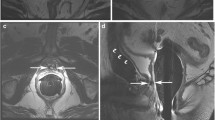Abstract
Purpose A preliminary project to correlate MR findings with mapping prostate biopsy to help differentiate malignant transitional zone lesions form benign prostatic hyperplasia (BPH) nodules. Materials and Methods Institutional IRB approved retrospective study with 14 patients suspected of having prostate cancer who underwent both prostate 3T MRI using endorectal coil and 3D transperineal mapping prostate biopsy. MR exams were independently reviewed by two abdominal radiologists blinded to pathology with disagreement resolved by consensus. An MRI lesion was defined as having hypointense T2 signal subjectively without corresponding T1 high signal intensity and low signal on ADC maps in the central gland. Mapping biopsy consisted of systematic transperineal US guided biopsy with 55–108 cores per patient. Results Twenty-nine lesions were detected on MRI. Of these, 13 correlated with Gleason 6 or higher biopsy samples. 16 were biopsy negative. Among the various MRI characteristics assessed, lack of T2 hypointense rim demonstrated the highest specificity (93%) and positive predictive value (89%). Highest sensitivity (85%) and negative predictive value (78%) were seen with ill-defined nodules. When suspicious MR characteristics were combined, the specificity and PPV rose to 100% while sensitivity decreased to 45% and NPV decreased to 73%. Conclusions Preliminary study indicates MR findings which can help differentiate a BPH nodule from transitional zone prostate cancers which could help direct biopsy in the large and growing number of people suspected of having prostate cancer. Further work will be needed for validation.






Similar content being viewed by others
References
Group, U.S.C.S.W., United States Cancer Statistics: 1999–2010 Incidence and Mortality Web-based Report. 2013, U.S. Department of Health and Human Services, Centers for Disease Control and Prevention and National Cancer Institute: Atlanta.
Murphy G, et al. (2013) The expanding role of MRI in prostate cancer. AJR Am J Roentgenol 201(6):1229–1238
Kelloff GJ, et al. (2009) Challenges in clinical prostate cancer: role of imaging. AJR Am J Roentgenol 192(6):1455–1470
Leake JL, et al. (2014) Prostate MRI: access to and current practice of prostate MRI in the United States. J Am Coll Radiol JACR 11(2):156–160
Mowatt G, et al. (2013) The diagnostic accuracy and cost-effectiveness of magnetic resonance spectroscopy and enhanced magnetic resonance imaging techniques in aiding the localisation of prostate abnormalities for biopsy: a systematic review and economic evaluation. Health Technol Assess 17(20):281
Ruprecht O, et al. (2012) MRI of the prostate: Interobserver agreement compared with histopathologic outcome after radical prostatectomy. Eur J Radiol 81(3):456–460
Akin O, et al. (2006) Transition zone prostate cancers: features, detection, localization, and staging at endorectal MR imaging. Radiology 239(3):784–792
Hoeks CMA, et al. (2011) Prostate cancer: multiparametric MR imaging for detection, localization, and staging. Radiology 261(1):46–66
Ikonen S, et al. (2001) Prostatic MR imaging. Acta Radiol 42(4):348–354
McNeal JE, et al. (1988) Zonal distribution of prostatic adenocarcinoma. Correlation with histologic pattern and direction of spread. Am J Surg Pathol 12(12):897–906
Kanao K, et al. (2013) Can transrectal needle biopsy be optimised to detect nearly all prostate cancer with a volume of ≥0.5 mL? A three-dimensional analysis. BJU Int 112(7):898–904
Liu X, et al. (2013) Differentiation of central gland prostate cancer from benign prostatic hyperplasia using monoexponential and biexponential diffusion-weighted imaging. Magn Reson Imaging 31(8):1318–1324
Oto A, et al. (2010) Prostate cancer: differentiation of central gland cancer from benign prostatic hyperplasia by using diffusion-weighted and dynamic contrast-enhanced MR imaging. Radiology 257(3):715–723
Li H, et al. (2006) Conventional MRI capabilities in the diagnosis of prostate cancer in the transition zone. Am J Roentgenol 186(3):729–742
Hoeks CMA, et al. (2013) Transition zone prostate cancer: detection and localization with 3-T multiparametric MR imaging. Radiology 266(1):207–217
Alonzi R, Padhani AR, Allen C (2007) Dynamic contrast enhanced MRI in prostate cancer. Eur J Radiol 63(3):335–350
Ren J, et al. (2008) Dynamic contrast-enhanced MRI of benign prostatic hyperplasia and prostatic carcinoma: correlation with angiogenesis. Clin Radiol 63(2):153–159
Barqawi AB, et al. (2011) The role of 3-dimensional mapping biopsy in decision making for treatment of apparent early stage prostate cancer. J Urol 186(1):80–85
Crawford ED, et al. (2013) Clinical-pathologic correlation between transperineal mapping biopsies of the prostate and three-dimensional reconstruction of prostatectomy specimens. Prostate 73(7):778–787
Dimmen M, et al. (2012) Transperineal prostate biopsy detects significant cancer in patients with elevated prostate-specific antigen (PSA) levels and previous negative transrectal biopsies. BJU Int 110(2b):E69–E75
Wei JT, Calhoun E, Jacobsen SJ (2005) Urologic diseases in America project: benign prostatic hyperplasia. J Urol 173(4):1256–1261
Jung SI, et al. (2013) Transition zone prostate cancer: incremental value of diffusion-weighted endorectal MR imaging in tumor detection and assessment of aggressiveness. Radiology 269(2):493–503
Weinreb JC, et al. (2009) Prostate cancer: sextant localization at MR imaging and MR spectroscopic imaging before prostatectomy—results of ACRIN prospective multi-institutional clinicopathologic study. Radiology 251(1):122–133
Author information
Authors and Affiliations
Corresponding author
Rights and permissions
About this article
Cite this article
Pokharel, S.S., Patel, N.U., Garg, K. et al. Multi-parametric MRI findings of transitional zone prostate cancers: correlation with 3-dimensional transperineal mapping biopsy. Abdom Imaging 40, 143–150 (2015). https://doi.org/10.1007/s00261-014-0199-5
Published:
Issue Date:
DOI: https://doi.org/10.1007/s00261-014-0199-5




